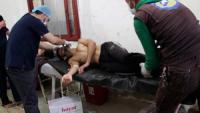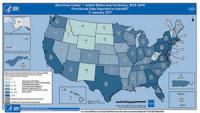-
A big-picture look at the world’s worst Ebola epidemic: West Africa, 2013-2016
The 2013-2016 West African Ebola epidemic dwarfed all previous central African outbreaks of the virus, sickening more than 28,000 people and killing more than 11,000 of them. New study of the epidemic reveals insights into factors that sped or slowed the rampage – for example, that the epidemic unfolded in small, overlapping outbreaks with surprisingly few infected travelers sparking new outbreaks elsewhere, each case representing a missed opportunity to break the transmission chain and end the epidemic sooner. Scientists call for using real-time sequencing and data-sharing to contain future viral disease outbreaks.
-
-
Improving predictions of outbreaks of Ebola, Lassa fever
Many of the major new outbreaks of disease, particularly in Africa, are so-called zoonotic infections, diseases that are transmitted to humans from animals. The Ebola virus, for example, which recently killed over 11,000 people across Africa, was most likely transmitted to humans from fruit bats. Potential outbreaks of diseases such as Ebola and Lassa fever may be more accurately predicted thanks to a new mathematical model developed by researchers at the University of Cambridge. This could in turn help inform public health messages to prevent outbreaks spreading more widely.
-
-
In West Africa, investment key in adapting to climate change
Climate change will likely have negative impacts on food production in West Africa, with crop yields and grass for livestock grazing likely to decline in the future. A new study provides insights on how strategic planning by decision makers could ease or exacerbate food security challenges in the region.
-
-
Medical evidence confirms sarin gas was used in Syria chemical attack

Turkey’s health minister said that traces of sarin gas have been detected in blood and urine samples from victims injured in the town of Khan Sheikhun in Syria on 4 April, offering “concrete evidence” of its use in the attack. Isopropyl methylphosphonic acid, a chemical which sarin degrades into, was found in the blood and urine samples taken from the patients who arrived in Turkey. Many of the victims of last week’s attack were taken to Turkey for treatment because the Assad regime and Russia, as part of their war strategy, have destroyed many of the medical facilities in the Sunni areas of Syria.
-
-
Enzymes versus nerve agents: Designing antidotes for chemical weapons

Nerve agents, a class of synthetic phosphorous-containing compounds, are among the most toxic substances known. Brief exposure to the most potent variants can lead to death within minutes. Once nerve agents enter the body, they irreversibly inhibit a vitally important enzyme called acetylcholinesterase. Its normal job within the nervous system is to help brain and muscle communicate. When a nerve agent shuts down this enzyme, classes of neurons throughout the central and peripheral nervous systems quickly get overstimulated, leading to profuse sweating, convulsions and an excruciating death by asphyxiation. There is a path to mitigate the danger of chemical weapons. This route lies within the domains of science – the very same science that produced chemical weapons in the first place. Researchers in the United States and around the world are developing the tools needed to quickly and safely destroy nerve agents – both in storage facilities and in the human body. There are promising advances, but no enzyme yet exists which is efficient enough for lifesaving use in people. It is worth keeping in mind the awesome and often complex power of science, however: We may be only a few years away from developing the kind of therapeutics that would make chemical weapons a worry of the past.
-
-
Monitoring the emergence of infectious diseases
Zoonotic diseases that pass from animal to human are an international public health problem regardless of location — being infected with Campylobacter from eating undercooked chicken in the U.K. is not uncommon, for example — but in lower-income countries the opportunities for such pathogens to enter the food chain are amplified.
-
-
Study: NIH funding generates large numbers of private-sector patents

Research grants issued by the National Institutes of Health (NIH) contribute to a significant number of private-sector patents in biomedicine, according to a new study. The study, published in the journal Science, examines twenty-seven years of data and finds that 31 percent of NIH grants, which are publicly funded, produce articles that are later cited by patents in the biomedical sector. “The impact on the private sector is a lot more important in magnitude than what we might have thought before,” says one of the researchers.
-
-
Addressing the threat of Zika virus to the U.S. blood supply
Investigators have shown that certain screening methods that detect the genetic material of Zika virus can be used to ensure that donated blood supplies remain free of the virus. The methods, called Zika virus nucleic acid amplification technology assays, demonstrated similar excellent sensitivities to assays currently used for screening for transfusion-transmitted viruses. The methods were substantially more sensitive than most other laboratory-developed and diagnostic Zika virus assays.
-
-
Predicting Zika hot spots in the U.S.

Where in the continental United States is Zika most likely to occur? Researchers puts the bulls-eye of Zika transmission on the Mississippi delta. They also predicted the virus, which is spread sexually and by bites from the Aedes aegypti mosquito, is likely to be transmitted in southern states extending northward along the Atlantic coast and in southern California.
-
-
Famine: Nearly 1.4 million children at risk of death in Nigeria, Somalia, South Sudan, and Yemen

Famine is looming in north-east Nigeria, Somalia, South Sudan, Yemen, and beyond, as nearly 1.4 million children are at imminent risk of death from severe acute malnutrition this year. Some 22 million children are hungry, sick, displaced, and out of school due to war, conflict and drought. They now face the risk of death from starvation, but also from preventable diseases like cholera and measles, which cause severe diarrhea and dehydration. This crisis is largely human-made. Scorched earth tactics by conflicting parties are destroying crops and critical infrastructure like health facilities. Heavy fighting is forcing farmers to abandon their fields, while blocking humanitarian access to people in desperate need of food aid and clean water.
-
-
Under climate change, farming is becoming riskier
Climate change will have an impact on agriculture, but a new study puts these changes in terms which are directly applicable to farmers. For Illinois, for example, the corn planting window will be split in two to avoid wet conditions in April and May. Each planting window carries increased risk – the early planting window could be thwarted by frost or heavy precipitation, and the late window cut short by intense late-summer drought. Farmers and crop insurers must evaluate risk to avoid losing profits.
-
-
House, Senate committees approve agroterrorism bill
The U.S. House of Representatives Homeland Security Committee and U.S. Senate Homeland Security and Governmental Affairs Committee passed the Securing our Agriculture and Food Act, clearing a key hurdle for the bill’s consideration by the full House and Senate. The Securing our Agriculture and Food Act requires the Secretary of Homeland Security (DHS), through the Assistant Secretary for Health Affairs, to lead the government’s efforts to secure the U.S. food, agriculture, and veterinary systems against terrorism and high-risk events.
-
-
EPA awards $100 million to Michigan for Flint water infrastructure upgrades
The U.S. Environmental Protection Agency (EPA) last week awarded a $100 million grant to the Michigan Department of Environmental Quality to fund drinking water infrastructure upgrades in Flint, Michigan. The funding, provided by the Water Infrastructure Improvements for the Nation Act of 2016, or WIIN, enables Flint to accelerate and expand its work to replace lead service lines and make other critical infrastructure improvements.
-
-
Targeting of Syrian healthcare as “weapon of war” sets dangerous precedent: Experts

The strategy of using people’s need for healthcare against them by violently denying access sets a dangerous precedent that the global health community must urgently address, researchers say. As new estimates of death toll for health workers are published, experts say the deliberate and systematic attacks on the healthcare infrastructure in Syria – primarily by government forces – expose shortcomings in international responses to health needs in conflict.
-
-
Universal public coverage of 117 essential medicines would improve access, save billions
A list of 117 essential medicines — including antibiotics, insulin, heart medication, anti-depressants, oral contraceptives, and more — accounted for 44 percent of all prescriptions written in Canada in 2015, and up to 77 percent of all prescriptions when therapeutically similar medications were considered. Researchers calculated that publicly funding these 117 essential medicines could cover the cost of nearly half of all prescriptions in Canada, removing financial barriers for Canadians while saving $3 billion per year.
-
More headlines
The long view
We Ran the C.D.C.: Kennedy Is Endangering Every American’s Health
Nine former leaders of the Centers for Disease Control and Prevention (CDC), who served as directors or acting directors under Republican and Democratic administrations, serving under presidents from Jimmy Carter to Donald Trrump, argue that HHS Secretary Roert F. Kennedy Jr. poses a clear and present danger to the health of Americans. He has placed anti-vaxxers and conspiracy theorists at top HHS positions, and he appears to be guided by a hostility to science and a belief in bizarre, unscientific approaches to public health.
